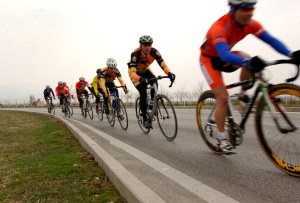This article titled “Do cycle lanes increase safety of cyclists from overtaking vehicles?” popped on up on chemistry news feed recently. I couldn’t understand where the chemistry came into that question (are new bike lanes being made from some novel material? does it have something to do with the material of tires? was this some kind of play on words that I didn’t understand?) so I opened the article only to find it wasn’t about chemistry at all. But it was interesting.
If you’re European or live in an American college town, you probably see a lot of bikes during your daily commute. If there are bike lanes, you probably get momentarily nervous when you see a cyclist. If there are no lanes and you’re anything like me, you’re probably simultaneously annoyed that you have to slow down and terribly worried that you’ll kill someone. Surprisingly, there’s debate on whether bike lanes are safe or risky. Some studies have found that drivers pass cyclists more closely, racing by at higher speeds, when bike lanes are present.
So, of course, this needed study. By strapping cameras onto cyclists, researchers determined that whether or not there’s a bike lane isn’t the main factor in cyclist safety. The width of the road, opposing vehicle flow, and the absence or presence of street-side parking were more important in determining how fast a car passed a cyclist. This makes intuitive sense. If the road is wide, there’s more room to move away from the bike. If there’s a car coming in the opposite direction, you’re probably not going to move over as much. A nearby parked car will take up some of that precious road room and make for a tighter squeeze.
The overall conclusion seems to be that we should focus less on bike lanes and more on wider roads. That is, until Google Driver comes along and solves all our automotive problems.

My own experience has shown that when there is no cycle lane, roughly half the drivers will pull at least halfway into the other lane to pass, and half will squeeze past the cyclist without changing lanes. (I guess they think that bikes are only as wide as their tire track on the ground the way most cars are?) For the most part, larger vehicles pull out more because they know they’re big, and smaller vehicles try to squeeze into the lane with a cyclist more because they think they’re small, they’ll fit… with the exception of SUVs who often seem to think they’re compact cars. Oh, and this is in a very bike-friendly city, by north american standards. In less bike-friendly cities, it’s worse.
The percentage of drivers who will keep their cars out of a painted bike lane is much higher. That white line is a barrier, it seems.
Pingback: Practicing Science | Tricked By Astrophysics